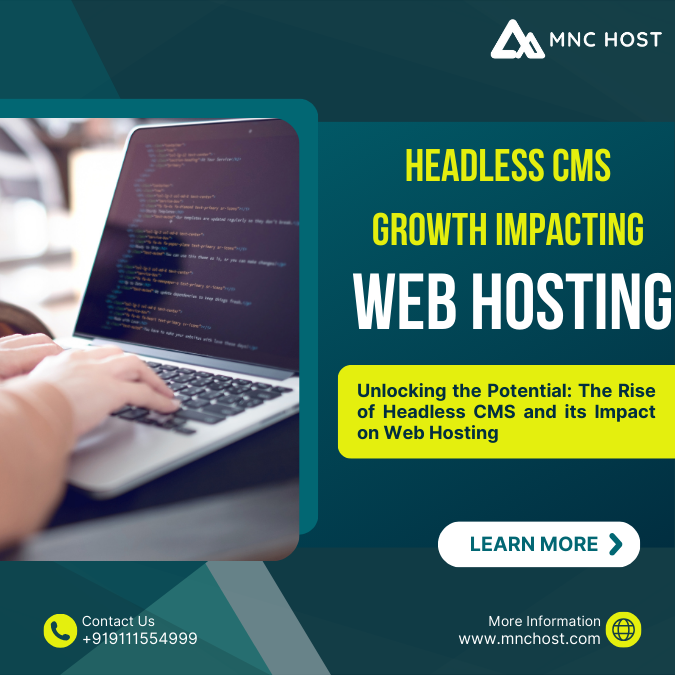
The terrain of web development and content management has been completely altered as a result of the emergence of headless CMS, which is the CMS that is at our current exit. Unsurprisingly, CMS platforms such as WordPress or Joomla have been the prominent tools for dealing with content management, and users’ dissemination which has taken place for ages. Nonetheless, headless CMS now combatted this model of publishing process that inertly separates the backend portion of CMS to the frontend browsing layer. This transformation however would bring in its own set of ramifications for web hosting, thereby causing problems and creating new opportunities for developers and businesses alike.
Understanding Headless CMS
Having an HTML version of this information is vital to understanding the impact of a headless CMS on web hosting, as well as why this type of CMS system has become so popular. In contrast to the head close backend of traditional CMS that tightly embeds the content management backend with the frontend presentation layer, headless CMS distributes content to clients through APIs (Application Programming Interfaces). Such indicates that the producers have backend admin over the content to manipulate it in the manner of style and layout without sticking to the frontend design and framework.
Developers in the headless architecture can enjoy flexibility to construct the frontend by using any programming language or framework; may it be a website, a mobile app or an IoT device. This decrease in the dependency of the content on file type enhances the flexibility of the developers to deploy highly customized as well as interactive user experience by using the CMS freely from the limitations of traditional file based systems.
Impact on Web Hosting
The rise of headless CMS brings several implications for web hosting providers and developers:The rise of headless CMS brings several implications for web hosting providers and developers:
1. Scalability and Performance: Headless CMS architecture is built on the scaling principle since with the decoupling of the front-end from the backend content delivery infrastructure the scalability grows. By this the websites may have ability to handle greater traffic effectively that they can be loading faster which is the combination of efficient frontend and backend optimization. Scalability will be the strongest asset of web hosting providers. A lot of providers already experimented with different models and offers and this trend will lead to the demand of infrastructure solutions supporting headless CMS deployments.
2. Specialized Hosting Services: The more accepted a headless CMS, the higher will be a market for the services targeting this architecture. Since there is a direct competition from other providers offering headless CMS hosting solutions, providers with a specialized technical framework for hosting can easily differentiate themselves from the competition and stand out in the market by providing high performance infrastructure, developer tools, and support for popular headless CMS platforms like Strapi, Contentful or Sanity.
3. Serverless Architectures: New proceeding to severless architectures, where the code is executed as a respond to events, not required to maintain the server infrastructure. Serverless architecture companies like AWS Lambda and Google Cloud Functions are poised to capitalize on the winds of change and shift because of the growth trend of headless content management systems by offering scalable and economical hosting solutions that fit the serverless architecture.
4. Content Delivery Networks (CDNs): CDNs (Content Delivery Networks) assume the role of the key factors in providing content the users in a fast way, especially to the headless content management systems, where content is delivered via APIs. CDNs can be utilized by web hosting providers to improve the resilience and accessibility of headless CMS in production through the process of content setup at the edge nodes that are closer to end-users thus leading to the reduction of latency and costs for bandwidth.
5. Security and Compliance: Security, as usual regardless of web environs, should be primary consideration in headless deployments which may include sensitive and confidential data. Among hosting providers, the issue of robust security is quite delicate and fixing that up include encryption, access controls, and regular audits will actually help this issue.
6. Developer Experience: A headless CMS granting the developers greater control over frontend development process is indicative of headless CMS empowering the developers. A hosting provider can intensify the developer experience via integrated development environments (IDEs), version control systems, and deployment pipelines that are the most suitable and run smoothly for the headless CMS workflows. For example, one of the major contributions could be the provision of sufficient grand and support for popular headless CMS platforms that developers can use for trouble-free building and deploying of their headless applications.
Future Outlook
Given the taping of installing these type of CMSes is on high, the influence on hosting will only be enlarged. The hosting companies that grab the chances funded by the headless architecture and design the products that are suitable to the entry market will surely occupy the most powerful market position in the near future. Whether it is flexibility of scaling, characteristics of performance, privacy and developer experience, headless CMS is changing the way of thinking about web hosting and offering new developmental options for businesses to advance.